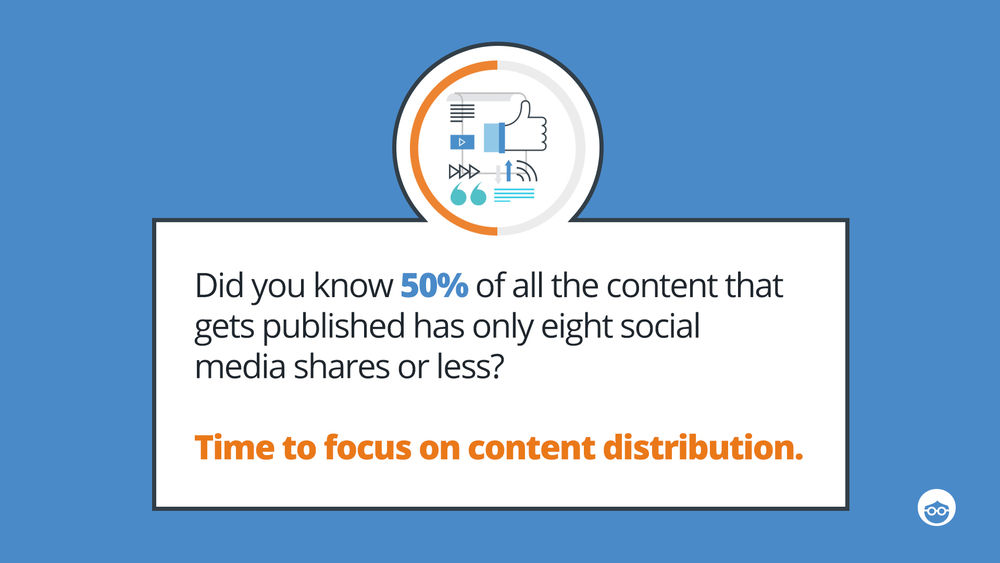7 Content Distribution Mistakes You Should Avoid

According to a study by Content Marketing Institute, the percentage of B2B companies doing some form of content marketing stood at 88% for 2016. With it only going to increase further in 2017. But the million dollar question is — how many of them are getting it right?
The answer is… not many.
These numbers will tell you the story.
- Only 30% of B2B marketers say their organizations are effective at content marketing.
- Only 44% of B2B marketers say their organization is clear on what content marketing success or effectiveness looks like.
- Only 48% of B2B marketers have a documented content marketing strategy.
- only 26% of marketers are investing in content distribution, even though more than half believe they need to.
It clearly shows that a lot of marketers are still struggling to grasp content marketing. To make things worse, the amount of content being produced daily has reached ridiculous levels (1400 new blog posts/ minute). This makes it all the more difficult for your content to get discovered, let alone stand out. It is probably why almost 50% of all the content that gets published have only eight social media shares or less.
One of the major reasons for this ineffectiveness is not giving due importance to content distribution. If your distribution strategy is ineffective, chances are that your content will not be seen by many. Rendering the entire process meaningless and just a waste of money and effort.
So, here are a few of those content distribution mistakes that you could be committing; plus, tips to avoid them:
- You don’t have a distribution plan
- You’re focused on the wrong KPIs
- You don’t understand your audience
- You’re not investing in paid campaigns
- You’re not testing your newsletters
- You implement the same strategy for all social media platforms
- You don’t leverage relationships
1.You don’t have a distribution plan
You can’t afford to approach content distribution with a one-size-fits-all mindset. It could lead to problems like:
- No fit between the content and the distribution channel.
- The channel you have chosen may not be popular with your audience.
- Not able to measure, track and review the impact your content effectively.
How to resolve this: Before the creation process for a piece begins, ensure that you have a roadmap designed for its promotion, based on the topic, target audience, and expected results. It should include details such as how, when, and where you are going to distribute the content.
2. You’re focused on the wrong KPIs
Imagine you have created a video and uploaded it to Youtube. The KPI you decided to measure was “likes.”
Few days in, you notice the “likes to view count ratio” is very good. You are happy and expected it to gain momentum in the coming days.
After a week, you notice that things haven’t improved as expected. Even though the “likes to view count ratio” is still good, the view count hasn’t increased as expected. That’s when you realize it: the “share count” is very low.
It is a simple example, but it clearly shows why we need to choose the right content marketing KPIs. Defining the wrong KPIs can really hurt your content distribution efforts. Especially, as it takes a bit of time to yield results, you will not know if you are on the wrong track.
How to fix this: KPIs should be selected on the basis of your target audience, message type, and desired interaction.
3. You don’t understand your audience
Do you know where your target audience spends their time? Do you know how to get their attention on those platforms?
If you are not in sync with your target audience, you will face problems like:
- Focusing your efforts on a distribution channel that is not preferred by your audience.
- Sharing your content at the wrong times of the day.
- Choosing a content presentation format that is not preferred by your audience.
Your target audience should be the center of your content efforts – right from niche selection to distribution platform selection.
For example, if your target audience mainly consists of freelancers, you should:
- Visit the places where they hang out – Upwork community, Reddit, lifehack.com, copyblogger.com, or thebalance.com.
- Participate in discussions.
- Interact with a few writers on platforms like Twitter or LinkedIn.
- Find out more about their content consumption behavior — their preferred channel, the type of content they prefer, the time at which they normally read, and how they interact with the content.
- Start researching your competitors content, and find out what’s been working for them.
Incorporating these insights into every stage of your content marketing efforts will ensure that it is relevant and helpful to your target audience.
4. You’re not investing in paid campaigns
A lot of companies are hesitant about investing in paid distribution channels because they are not very clear about its impact. Let’s clear the air about this first. When you should adopt a paid channel:
- If you are launching a new campaign, and want to achieve results faster.
- If you are looking to get more out of your high-performing content.
It will be difficult to generate results relying solely on organic traffic in these two scenarios. That’s why you need paid distribution to give your content that extra boost.
There are many paid distribution platforms out there. Outbrain stands out, because you can place your articles in high authority websites like Time, CNN etc. Plus, the cost per click comparatively cheaper, $0.30 and it offers better targeting too.
Point to remember: The traffic generated with paid distribution is not sustainable, it will only last till your last payment. Thus, you need to use it prudently. Plus, have systems in place to convert this paid traffic into organic.
5. You’re not testing your newsletters
Are you serious? No wonder your content is not performing well.
Email newsletters are a great channel to distribute content. They are direct, intimate, and popular. But, if you think of it merely as an email blast, you couldn’t be more wrong. If you approach it this way, your open rates and unsubscribe rates will suffer.
Getting it right requires effort. You need to keep A/B testing to find out elements that are working and that needs tweaking. Plus, it will help you an in-depth understanding of how your contacts interact with your newsletter.
- Tips to keep in mind:
- Test one element at a time.
- Test whether your email pass spam tests
- Test how it looks on different mobile devices.
- Segment your list to ensure relevance.
- Test the images, links, and alt text.
6. You implement the same strategy for all social media platforms
Each network serves a different purpose, the persona of the average user varies from one platform to another. For instance, Snapchat users and Twitter users are completely different. Their age groups, likes, hobbies, and education levels vary. So, a one-size-fits-all strategy is not the right choice.
Knowing the audience and how they prefer to spend their time online and determining what content is appropriate for certain networks will help a content distribution strategy succeed. To determine what works best for you, research what makes the audience tick when it comes to online usage.
- Is the audience spending more time on Facebook, Twitter, LinkedIn, etc.?
- How much time do they spend on each network?
- You should also monitor and listen to comments, which will enable you to determine how engaging the content is and how well it’s being responded to on certain networks.
7. You don’t leverage relationships
If you are not building new relationships or leveraging existing ones for content distribution, you are wasting away an avenue that is cost-effective and has immense potential. It may take a little time, the first time around, but once you have laid the groundwork, you can easily automate the process.
How to fix this: Have a central database where you collect the contact information for all of your networks. This could include everyone from influencers that you have mentioned in your articles to people you have met at conferences to your college alumni groups. Identify the contacts who will find the content that you have just created useful and relevant. Reach out to them via email or other social media platforms where they are active, informing them about your latest piece of content. Adopting an email management tool will make it easier to handle and stay on top of these conversations.
Points to remember:
- Keep cleaning and updating the database regularly.
- Regularly share and engage with their content without being asked.
- Make an effort to keep in touch with them.
Wrapping up
Unless you take content distribution seriously and make sure it is in alignment with the company’s overall marketing goals, your content marketing efforts will never realize its potential.
Even though the best way to go about content distribution is to adopt a trial and error approach, keeping an eye out for the mistakes listed above will make the process a lot easier.













